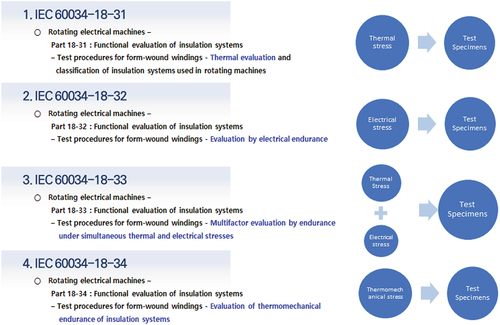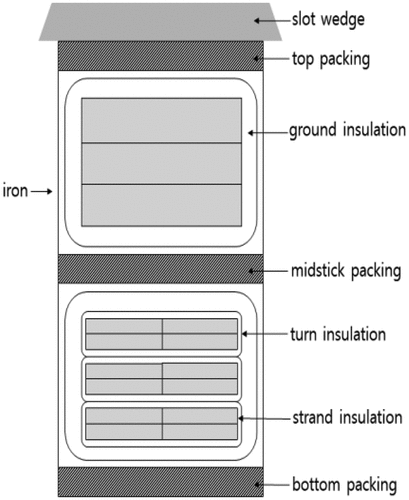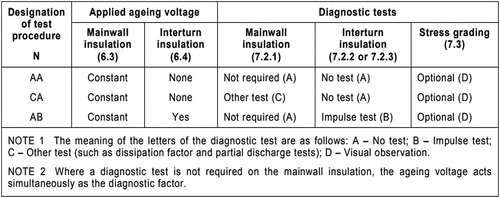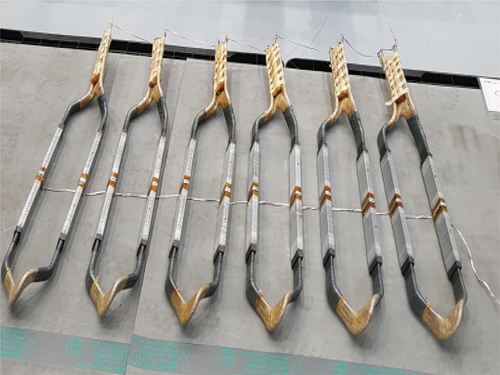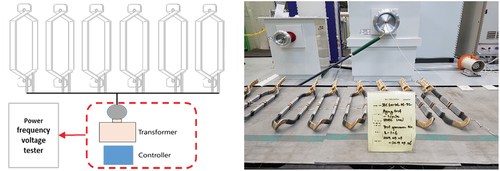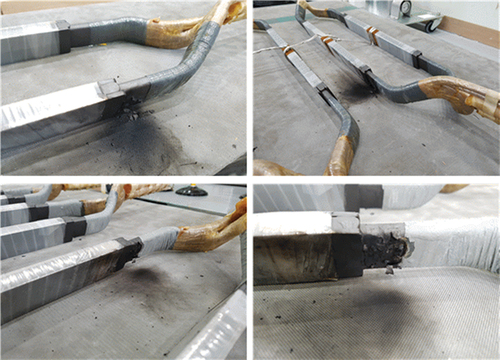ABSTRACT
Reliability studies of existing rotating machine insulation systems mainly focused on reliability evaluation for diagnosis and life prediction of generators and motors of various onshore power plants. However, with the increase in commercial rated voltage of marine rotating machine, accidents related to insulation systems occur frequently, and since many difficulties are caused in repair and replacement, the demand for improved reliability of marine high-voltage rotating machine is increasing.
Accordingly, several international classification societies have begun to require tests to confirm the reliability of the insulation system of high-voltage rotating machine for ships. For the first time among them, in accordance with Rule Proposal No.2015/EL01 (Rules and Regulations for the Classification of Ships, 2016) at Lloyd, international classification for generators and motors contracted after July 2016 is required. It was requested to present the insulation deterioration reliability results of the rotating machines insulation system according to the standards (IEC 60,034-18-31, IEC 60,034-18-32, IEC 60,034-18-33, IEC 60,034-18-34).
In this paper, in order to check the weak points of the high-voltage rotating machinery of a ship against voltage deterioration among the above four standards, a test procedure was developed in accordance with the IEC 60,034-18-32 standard, and the weak points were identified and analyzed through testing did.
Introduction
Recently, the rated voltage of inboard generators or electric motors (Bow Thruster motor, Main L.O Pump motor, Main Compressor motor, etc.), which are major equipment in ships, is becoming higher and higher voltage. Due to the large size, eco-friendliness, and light weight of ships, it is inevitable to change from low voltage to high voltage, and accordingly, reliability analysis of generators or motors on board is absolutely necessary.
Failures of generators and high-voltage motors occur suddenly, damage is large, and restoration is difficult in a short time, and restoration costs are relatively high. Even in developed countries, interest in the failure prevention of these rotating machines is very high, and continuous efforts are being made to develop technology for failure prevention.
The causes of high voltage generator accidents were investigated as stator winding (50%), exciter (18.5%), bearing (13.5%), rotor winding (7%), and others (11%). Deterioration (44.9%), brain damage (26.3%), spillover accidents (12.3%), and others (16.5%) were found. The causes of failure of high voltage motors were stator winding (46.4%), rotor (9.6%), bearing (28.8%), and others (15.2%). In other words, about 50% of the failures are due to insulation deterioration of the stator winding (Calder et al. Citation2018).
Accordingly, in accordance with Rule Proposal No.2015/EL01 (Rules and Regulations for the Classification of Ships, 2016), Lloyd first complied with international standards (IEC 60,034-18-31, IEC 60,034-18-32, IEC 60,034-18-33, IEC 60,034-18-34) announced to present the insulation deterioration reliability results of the rotating machinery insulation system. shows an introduction to the IEC 60034-18-31,IEC 60034-18-32,IEC 600341-8-33,IEC 60034-18-34 standards.
High-voltage stator winding composition for marine use
The cross section of the stator winding of the high voltage rotating machinery for ships is composed as shown in the figure. As shown in the figure, insulation materials can be classified into strand insulation, turn insulation and ground wall insulation (Lee et al. Citation2020).
Glass fiber, DaglasTM fiber, synthetic enamel, and so on are used as wire insulation materials, and mica paper, polyamide/mica paper, enamel/mica, and so on are used as turn insulation materials.
Recently, chromium oxide has been developed instead of mica, and enamel chromium oxide has excellent internal partial discharge and is in the stage of practical use as a substitute for enamel/mica.
The main insulating material is known as a mica tape made in the form of a tape by mixing a binder and a reinforcing material with mica. Epoxy resin is used as a binder, and epoxy resin is currently used by most generator manufacturers because of its excellent durability against moisture and chemical components, mechanical and insulating properties compared to polyester used in the past.
The material used for the stator winding of the rotating machinery has a high dielectric strength, low tan δ value in a wide range of applied voltage and temperature, mechanical toughness, high heat resistance, and small change in withstand voltage, tan δ, and insulation under continuous heating conditions. In addition, the fatigue deterioration of the insulating material against continuous applied voltage and repeated mechanical stress should be small.
The structure of the stator winding of a rotating machinery can be largely classified into a bar (or half coil) and a multi-turn coil, and the point to consider when designing a winding is that the structure is determined by the rated capacity of the rotating machinery to be manufactured. shows cross section of the stator winding. In general, when the rotating machinery rated capacity is less than about 75 MW, it is manufactured with a multi-winding coil, whereas if it is more than that, a bar is usually used. Most of the ship’s generators and motors are made of multi-turn coils. Multi-turn winding consists of a wire group made of insulating copper wire with the required turn cross section, processing the surroundings with turn insulation, and finally winding the main insulation material into a diamond shape.
Development of test procedures according to IEC 60,034-18-32
A test procedure was developed based on IEC 60,034-18-32 to derive weak points according to the voltage of the stator winding. In the test standard, the test should be conducted with a voltage that can perform the aging cycle for about 10 cycles, and a total of three levels are selected, and the average failure time is 5000 h at the lowest level and 100 h at the highest level.
In this paper, since the purpose was to derive weak points according to voltage, it was conducted at the highest level, and the test procedure was configured to proceed with the voltage life test until the average failure time of about 100 h or more.
below is the test flow of IEC 60034-18-32 (Citation2010). Since there were no existing test cases, diagnostic tests were not performed for each cycle by applying AA. below is the Test procedure designation of IEC 60,034-18-32 (Citation2010).
According to the standard, the aging sub-cycle should be about 10 cycles, and the voltage that gives an average failure time of about 100 h or more was determined to be about 2.9 times the rated voltage. Therefore, at 19.14 kV, which is 2.9 times the rated voltage of 6.6 kV, each cycle interval was selected as 10 h.
Test configuration
Test specimens
The test specimen is to be tested with five or more diamond coils according to the IEC 60,034-18-32 standard, and in this test, the test was conducted with 6 specimens. All specimens were individually configured so that there was no interference between each specimen. shows the photo of the specimens setting.
Test configuration
Circuits were configured in parallel so that the same voltage could be applied to a total of six specimens, and the same withstand voltage equipment was used. below is the test structure.
Test equipment
The equipment used in the test was carried out with a long-term overvoltage tester owned by the Ulsan headquarters of the Korean Marine Equipment Research Institute. shows detailed equipment specifications.
Table 1. Test equipment.
Test results and analysis
During the aging test of the specimens for 10 cycles, 3 out of 6 specimens were destroyed, and it was found that the insulation was destroyed in all of the semiconducting layers connected to the slots. below is the electrical breakdown point of specimes.
This is because in the case of a rotating machinery stator winding used at a rated voltage of 6 kV or higher consisting of strand insulation, turn insulation and main insulation, insulation breakdown due to deterioration of the paint or semi-conductive layer tape that gives the insulation material of the winding an equal stress presumed to have occurred.
Conclusion
In this paper, in accordance with Rule Proposal No.2015/EL01 (Rules and Regulations for the Classification of Ships, 2016), a regulation enforced by the Lloyd, in relation to the ship rotating machinery insulation system accident, which is a recent issue, A voltage deterioration life evaluation test was conducted to find weak points of the voltage for the high voltage rotating machinery stator.
The test procedure was developed in accordance with the IEC 60,034-18-32 standard, which is the voltage deterioration life evaluation standard prescribed by the Lloyd, and the voltage weak points were identified according to the test progress and test result.
In actual ships, not only voltage deterioration but also various deterioration factors according to the marine environment (salt water, humidity, vibration, etc.) have many deterioration factors. In fact, most of the ships in operation are conducting open inspection and cleaning to improve the insulation of high-voltage stator in the dock work list.
As a result of this study, it is considered that accidents of high-voltage rotating machinery during ship operation can be prevented in advance if the condition of the semi-conductive layer is periodically checked and monitored during the dock opening inspection on a ship in operation.
Disclosure statement
No potential conflict of interest was reported by the author(s).
Additional information
Funding
References
- Calder, W., Snyder, D. P., & Burr, J. F. (2018). Experience with stator insulation testing and turn/phase insulation failures in the power generation industry. IEEE Transactions on Industry Applications, 54(3), 1–5. https://doi.org/10.1109/TIA.2018.2804322
- IEC 60034-18-31. (2012). Rotating electrical machines Part 18-31: Functional evaluation of insulation systems Test procedures for form-wound windings Thermal evaluation and classification of insulation systems used in rotating machines.
- IEC 60034-18-32. (2010). Rotating electrical machines Part 18-32: Functional evaluation of insulation systems test procedures for form-wound windings evaluation by electrical endurance.
- IEC 60034-18-33. (2010). Rotating electrical machines Part 18-33: Functional evaluation of insulation systems test procedures for form-wound windings multifactor evaluation by endurance under simultaneous thermal and electrical stresses.
- IEC 60034-18-34. (2012). Rotating electrical machines Part 18-34: Functional evaluation of insulation systems test procedures for form-wound windings evaluation of thermomechanical endurance of insulation systems.
- Lee, J. (2020). Method for diagnosing insulation deterioration and evaluation of dielectric strength of stator windings of high-voltage motors [ Master’s thesis]. Korea University

